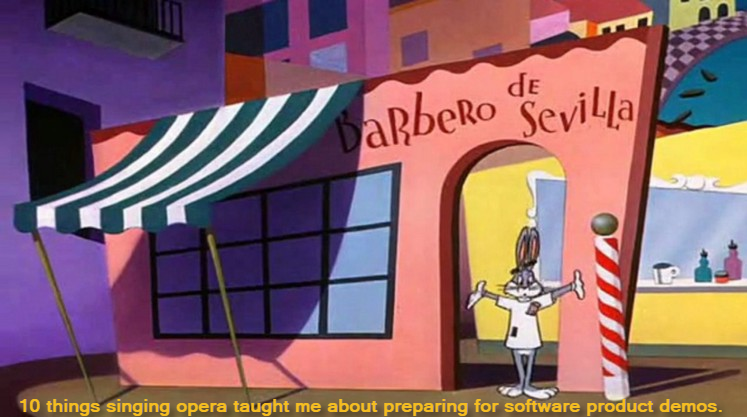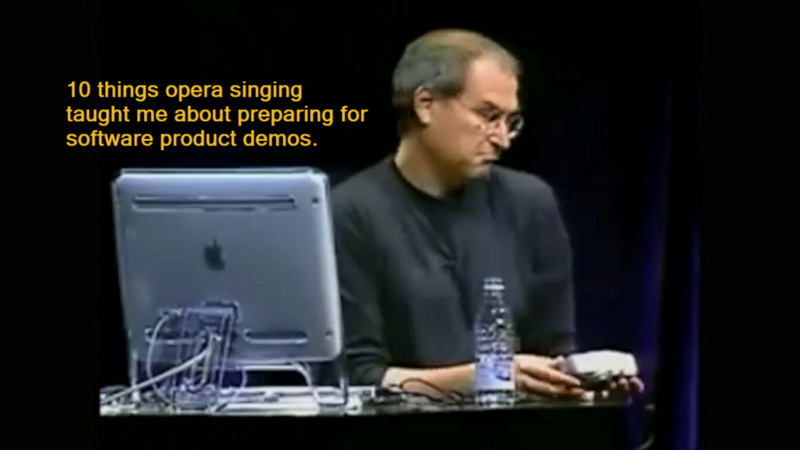TL;DR — Enjoy these 10 handy tips on preparing for software product demos I learned during my short career as a professional opera singer.
At about the 1:30 minute mark of the video drama titled ‘Apple Keynote Failures’ we witness yet another reminder that even the best-laid plans of mice and men tend to blow up badly when performed live in front of an audience.
Yet, I doubt we even need a video to drive this point home, as I would bet my beloved Mountain Bike that most experienced product managers have suffered software demo disasters similar to that of Steve Jobs.
But it doesn’t have to be this way.
Before I got into software, I was deeply engaged in another domain, one in which the performance was the product. And because of the nature of our human condition, such performances were equally prone ‘unplanned opportunities’ to tap dance and improvise.
You see, I used to sing opera, professionally, and before that, was heavily involved in musical theater. To ascend to a level where I was getting paid, training was required in a variety of practices, not the least of which was show prep.
My hope is that in sharing some of these techniques and tools from a performance arena, that you may not only be better equipped to endure the unexpected interruptions to your software product demo, but perhaps even embrace it …
… even when the network goes down, the sound system fries, an important prop gets knocked over at the 3:30 minute mark, and/or the application reveals previously undiscovered bugs during your presentation.
Intro
It has always amused me when I received free advice from individuals with absolutely no stage nor musical experience whatsoever. If I only had a nickle for every time I was asked “How do you get to Carnegie Hall?” Of course I would double-down on my amusement by replying with “I hope you don’t believe that myth that ‘Practice, Practice, Practice’ is all it takes.”
What do I mean by this? Glad you asked. Let me tell you a quick story.
I remember a voice teacher of mine describing a former student of whom he said “… he used to learn his music listening to old records, scratches and all.”
The lesson here was simple, if you practice the wrong thing, unrealistic scenarios, faulty personas, and/or/especially bad habits, then all you’ve done is perfect the delivery of imperfection.
Perfect practice makes perfect …
As product people, we all live and die by the understanding that perfection is the enemy of good. However, if you’re going to protect your product demo from unforeseen disasters, then here are some tips on how to practice the right thing:
- Memorize your materials — This is not always possible, but when feasible doing so allow you to quickly pivot if and when things go a bit wild.
- Simulate your walk-throughs —Engaging in dress rehearsals and technical shakedowns under realistic conditions will help you proactively identify unexpected issues.
- Practice more than once — This is in part to understand your part. It also has the advantage of exposing potential snafus when it doesn’t count.
- Learn the lines of your co-presenters — Don’t assume a team member won’t freeze, fumble, or otherwise flub their side of the story. Knowing what they should be saying and/or presenting equips you to jump in and move the demo forward when peers take on a deer in the headlights persona.
- Rehearse in front of strangers, or at least your mother — Don’t assume your audience will know what you know, nor possesses a relevant context they can quickly relate to your presentation. This is why I suggest testing your materials on others early and often. Otherwise you potentially risk an audience that tunes out, leaves, or perhaps goes old school and throws rotten tomatoes.
Those who fail to prepare are preparing to fail …
There also are some other things you can do as part of your show prep outside of perfect practice …because you never know when you’re doing a demo in a room where someone on daddy-duty has lost track of a three-year-old who in turn thinks the bright red off button on a master panel was the interesting toy in the room … not that this has ever happened before (ahem).
- Backups. Lots of backups — While everyone prefers a live demo, it doesn’t hurt to have screenshots, video snippets — and yes, if you must — PowerPoint presentation files available on BOTH a thumb drive and cloud storage. As sub-optimal as these may be, they can save a demo from total disaster when things like WiFi, databases, firewalls, and computers decide not to comply.
- Walk the set — Regardless of how many rehearsals I’ve had in a particular setting, live or online, I always arrive early to simply walk around to get myself focused. Sometimes in walking the room, you get lucky, and identify anything new or peculiar that may qualify as an impediment during the actual presentation.
- Sound & light check — Another advantage of arriving as early as possible is that you can often buy additional time with any technical staff. This means time to learn and test the microphone and projector. Time to understand the lighting and room acoustics. And time to gain audience perspective by sitting in some of the seats they’ll be sitting. Or at least time to find out you need to install an update to Skype, WebEx, or Goto Meeting.
- Warm-up exercises — I like to recommend tongue twisters as a fun way of getting ready vocally. I might also mention that it doesn’t hurt to stretch or do yoga to help stay lose while remaining focused. The voice is, after all, a full-body instrument.
- Avoid full rehearsals the day of — If there’s one bit of insanity I have always loathed from various musical, opera, and especially soloing in choral works, is the idiot director or conductor who insists on running a full rehearsal immediately before a performance. It only contributes to taking the edge of what would have otherwise been an exciting performance.
But Wait! There’s More …
At some point I need to write about how improvisation training I received as an emerging thespian has come in handy when nothing works. Same goes with reacting to change based on the audience feedback loop.
But this post is about show-prep, so bug me if I don’t write about these two important topics in the near future.
Point is, when something goes sideways during a software demo you often need to scramble. Having engaged in any one or all of the 10 steps above always helped me when visited by gremlins. I’m hoping they do the same for you.
Bonus Material!
One thing you should know about professional performers, we’re full of ‘war stories’ about when things go wonky.
Below are two stories from my performing days that a) hopefully reinforce my suggestions above and b) you find relatable in some ways to your product demos and c) find entertaining and delightful.

Practical Application Example #1 — Perfect Practice
So I’m playing the part of the one four travelers (a.k.a. hikers/rascals) in a production of the 1 act opera “Der Mond” by Carl Orff based on the text of a Grimm Fairy Tale of the same title. There is a point in which this lyric setting of lunar thievery where the second traveler is supposed to say “… we will fetch a [wagon] and horses and carry away the moon. The people here may buy themselves another.”
Problem #1, no wagon. Problem #2, the other 1 act being performed that afternoon was “Hansel und Gretel”, another 1 act based on a Grimm tale, only with a cast that includes about a dozen or so young children.
Problem #3 was that hiker who was supposed to deliver when the wagon appeared frozen in mortal fear because said wagon was amusing a dozen or so children in costume out in the parking lot behind the stage.
Because a couple of us had learned the parts of each other, we were able to improvise our way out of trouble, buying enough time for a panicked stage manager to retrieve and kick said cart magically on stage with a mighty push of his foot.
Seriously, the hardest thing after that was not to crack up laughing because of how hilarious the whole thing had worked out.
Practical Application example #2 — Having a backup plan & walking the set.
So I’m playing about 3 different character roles in a summer stock performance of Cabaret. For my second role as a carnival barker, I hear hear my cue and made my way to my entry downstage, right, only it was blocked by rolling coat rack that had been rolled into the wrong place.
Worse, on all sides of said cart there were about 5 or 6 dancers in various stages costume change. Pushing my way through was not a viable option.
Having rehearsed under realistic conditions, coupled with having walked the set earlier that evening, I was able to take advantage of a wider than standard leg drape upstage, making it to my mark just in time to catch the conductor’s cue from the orchestra pit.
What about you?
Tell me your stories. Yes, they can actually be product demos gone wrong. I’d love that. Nor would I mind some stories from strange stage experiences like mine.
Now pardon me while I work on something along the lines of “10 things singing opera taught me about MVP software feedback loops” (no really, give me a better title suggestion as this one is a bit klunky. I’ll give you full credit, links to your stories, and retweets).
